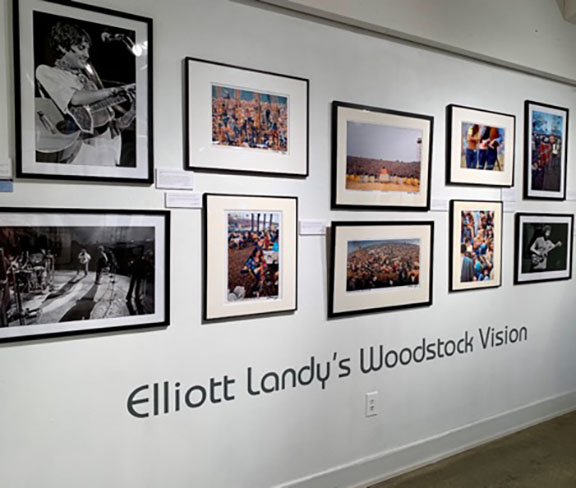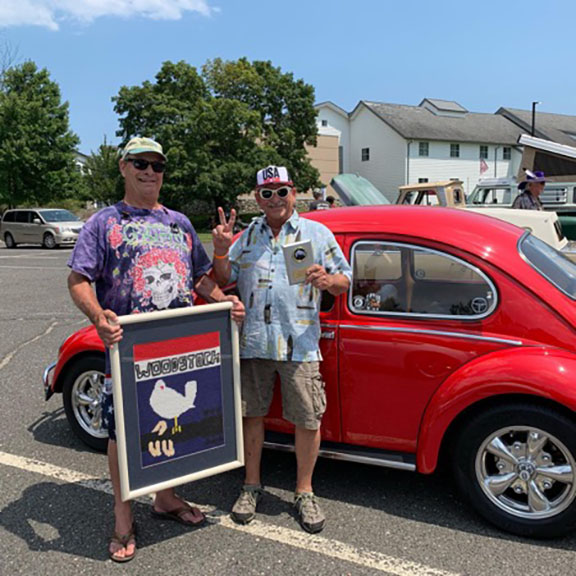By Sheilagh Casey
To quote Charles Dickens, “It was the best of times, it was the worst of times, it was the age of wisdom, it was the age of foolishness …” He was writing about the French Revolution, but he could have been talking about 1969 and the era that surrounded it.
This summer, the Monmouth Museum is hosting “Woodstock at 50: Summer of Love,” an exhibition recalling that amazing music festival exploring the art and events surrounding it. Showcasing 50 iconic photographs by Elliott Landy of the festival itself and influential musicians and personalities of the time, the show also brings together the voices of local residents and artists with loads of memorabilia, rock show posters, and a full schedule of participatory workshops and events for the whole community.

The Woodstock festival in August 1969 was a celebration of community and counterculture. It was unprecedented in its size and attraction: So many young people showed up without tickets that the organizers stopped collecting tickets on the first day, overwhelmed by the crowds. The audience size was estimated to be about 400,000 at its peak.
The exhibition was curated by Catherine Clark of the Monmouth Museum. She got the go-ahead to mount the exhibition in early spring of this year. That’s not much time for a show of this size, but Clark was up to the task. She started with an open call on social media asking people to send her materials related to the festival. She contacted photographer Elliott Landy. And she discovered that Steve McMillion of Red Bank FrameWorks had a collection of ‘60s posters and connections to collectors Larry Price and William Walsh.
Clark credits McMillion as a big help in putting the show up. They drove up to Woodstock, where Landy keeps the relevant collection, in a cargo van three days before the scheduled opening and gathered the 50 photographs that are the centerpiece of the show. Getting it together was “like a wild trip,” Clark said. “The Woodstock legacy touched the Monmouth Museum: The community came together.”
Brookdale Community College’s department of history and library helped with the planning. Jack’s Music in Red Bank sent a collection of relevant albums. Russo Music and Martin Guitars pitched in. (There’s a raffle for a limited edition Martin guitar ongoing.) Habitat for Humanity’s ReStore and the Vintage Variety Shop supplied furnishings of the era and many local residents contributed memorabilia from draft cards to patched denims. “Without partners who contributed,” Clark said, “this wouldn’t have happened.”
Tracy Walter Ferry of Little Silver contributed a short film of enhanced footage from 1960-69. Other videos are included. There’s a black-light hall, allowing younger people to experience a favorite look of the time, posters with an eerie glow, while relaxing in beanbag chairs.

Visitors have been enjoying the wild trip. For one Red Bank resident who preferred not to give his name, the show brings back “a lot of nostalgia stuff.” He found the photographs “remarkable.” As for the festival, “I went to one day. It was raining and all mud.” He had just graduated college after a stint in the Navy. Some of his favorite musicians at the time were Jimi Hendrix and Janis Joplin. “I was not in favor of their lifestyle, but their music was great.”
He protested the war, but objected to the harsh treatment some veterans experienced on their return stateside. “They weren’t going to win that war, but they kept on pouring money into it,” he said.
“ ’69 was the worst year,” he mused. His statement is arguably true or false. It was, after all, the year Neil Armstrong walked on the moon. But, politically, it was troubled. “When Walter Cronkite said ‘this war is not winnable,’” the museum visitor said, “that was really the end of it.” (Cronkite actually said the war was a stalemate.)
Nonetheless, President Lyndon Johnson announced shortly afterward that he would not seek a second term, leading to chaos and violence at the Chicago Democratic National Convention about two weeks after the Woodstock Festival. Richard Nixon subsequently won the ‘68 election as a law-and-order candidate. His tenure in office ended badly.
For some, the gallery experience is very different. Mateo, a 15-year-old visiting with his family from Freehold, said, “It’s all new to me. I’ve never seen anything like this before: the music, the style. I’ve never heard of anybody here.”
Christa, 27, from Keansburg, was familiar with a few of the musicians, and liked the mid-century style, but, “I’ve never seen any artwork from the ‘70s up close. I’m interested in the clothing and things. It’s just my style. I never realized the album covers had such great art on them.”
Catherine Clark has a favorite visitor tale. She overheard a young mother explaining the festival crowds to her toddler: “They all came to listen to music and make friends.”














